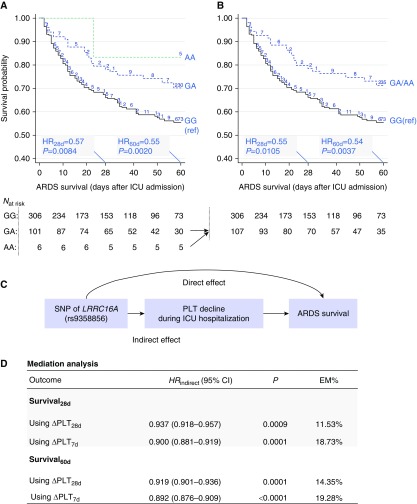Figure 1.
Association between single-nucleotide polymorphism (SNP) rs9358856 and acute respiratory distress syndrome (ARDS) survival and the effects mediated through platelet count. (A) Kaplan-Meier survival curves stratified by SNP rs9358856 genotypes in additive genetic model—wild type (GG; black line), heterozygous (GA; blue dashed line), and homozygous (AA; green dashed line). (B) Due to the small sample size of the AA group, AA was merged with GA group. Numbers on the Kaplan-Meier curves represent censored cases. Hazard ratios (HRs) per minor allele, 95% confidence intervals (95% CIs), and statistical P values were estimated by Cox regression with adjustment for age, sex, blood transfusion, baseline platelet count, and Acute Physiology and Chronic Health Evaluation III score. (C) The mediation model. (D) Results of mediation analyses for ARDS 28-day survival and 60-day survival. Results are described as observed indirect prognostic effect (indirect hazard ratio [HRindirect]) of the SNP that was mediated through platelet count decline, 95% CI, P value, and the proportion of effect mediated (EM%). Two mediators were considered: maximal platelet count decline within 28 days (∆PLT28d) and within 7 days (∆PLT7d) after intensive care unit (ICU) admission compared with the baseline platelet count. LRRC16A = leucine-rich repeat–containing 16A.

